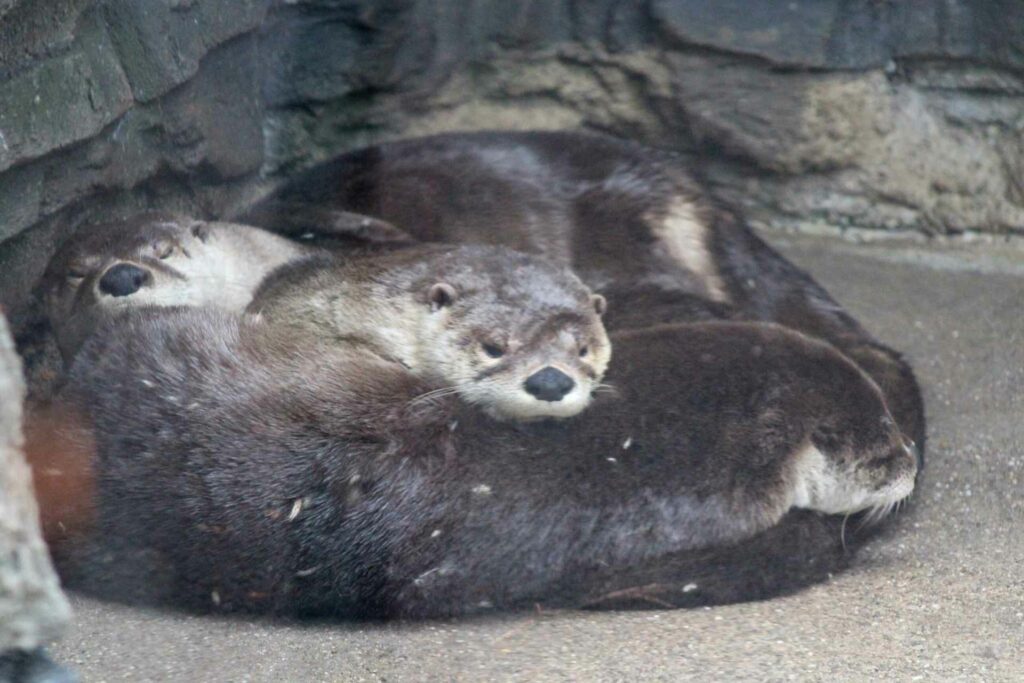FRENCH CREEK – One of West Virginia’s cutest native species is seldom seen in the wild, but when they are, you may want to find a different fishing spot.
Trevor Moore, wildlife biologist with the West Virginia Wildlife Center, said the North American river otter is a longtime native of West Virginia, and they are pros at catching fish. Three of the furry creatures currently reside at the Wildlife Center at French Creek.
“One of our females has been here for a while – I don’t know how long, but she’s a little bit older,” Moore said. “And then, one male and one female we actually caught last year in February. There was a disabled individual, and he was needing some help and law enforcement was responding to a complaint. These otters were emptying out his pond of the fish, so we thought we’d help him out, and we needed otters.”
The otter population was almost completely depleted in West Virginia before they were reintroduced in the 1980s.
“There was a big push by the DNR to get them back because they’d actually been driven nearly extinct in West Virginia due to over-trapping and pollution of the rivers,” Moore said. “In the 1980s, there’s was a big push to clean up West Virginia’s rivers, so a lot of regulations were passed on coal mining, where they couldn’t be dumping as much acid and other chemicals into the water from their waste, and then there was a big reintroduction of the otters in the mid-1980s.”
“Since then, they’ve just exploded and it’s been great,” Moore added. “They’re now almost to a nuisance level again, which is what we’d like to hear in reintroductions.”
The otter was reintroduced to balance the ecosystem in the rivers.
“Having a more diverse ecosystem is healthier and stronger, so when you’re missing a top predator like an otter in a river ecosystem, that does have cascade down the food web,” Moore explained.
Otters will eat several other types of creatures that live in the river or on its shore, including crayfish, turtles, snakes, mussels, clams, snails and their favorite dish, fish.
“Lots of people think they’re cute, but you have to remember these are animals are designed to eat meat. They have very sharp teeth, they have strong jaws and people need to be careful when they’re around them,” Moore said. “Otters by nature are very elusive – I want to say almost playful – and people see them, but they’ll often just be scampering into the water to get away from us …And if you’re fishing and there’s an otter around, you’re probably not going to catch anything.”
Otters are mostly loners, even keeping away from other otters unless a mother otter is raising pups or certain circumstances regarding food are involved.
“The males tend to not help to raise pups at all in the wild,” Moore said. “I think they’re fairly solitary, but they do have some social plasticity in their behavior, so when you find big concentrations of fish, you’ll actually find big groups of roving males. They will actually come together and hunt together, like in a pond or a lake and hunt these fish and then they just disperse. They all get together and work together for a while and get along and then once the food’s gone, they disperse again.”
A group of North American river otters is called a romp, and the otters at the center can frequently be seen cuddling and playing together.

“When they’re in captivity, they obviously always behave differently than when they’re in the wild, but even in the wild, they definitely will reinforce those social bonds by cuddling and sleeping together, and it helps with thermal regulation as well. If they’re cold, cuddling helps keep you warm,” Moore said. “It’s a very big thing to work and play together and keep those social interactions up, especially in a captive setting.”
The best time to see the otters at the Wildlife Center is during the summer months.
“The freezing [in the winter] destroys our pumps and once the temperature drops below a certain threshold, we can’t reliably produce chlorine into the water, and there has to be a little bit of chlorine just to help keep the standards that we have to keep as a zoological facility,” Moore said. “Typically, our otters are on display from May until whenever it gets cold, which is typically starting around October, but I think last October we had them a little while longer because it stayed a little warmer towards mid-October.”
Otters also have waterproof fur and special noses and ears to keep out water.
“They have some really cool adaptations,” Moore said. “They have waterproof fur, so it helps trap air to keep their skin dry, even though their fur is wet. They have specialized nose and ear muscles to help keep water out of their noses and ears so they can actually close those off while they’re swimming.”
Learn more about the West Virginia Wildlife Center, the animals who live there and the center’s history by visiting its website here.














